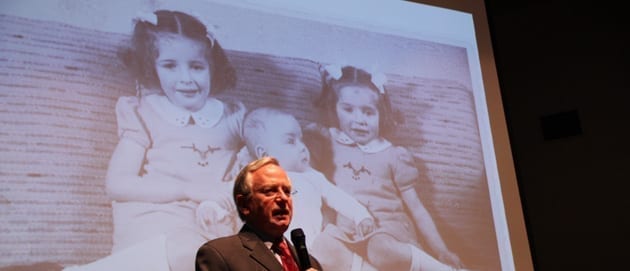Al Münzer shared his family’s story of sacrifice and survival with audiences totaling more than 2,000 on the campus of BRTC during the college’s Holocaust Survivor Series. With a backdrop of family photos, the Washington, D.C., physician chronicled the events of his family’s life from the time Hitler came to power in 1933 through the next twelve years.
The presentation marked the 8th such presentation by a Holocaust Survivor. The event is made possible through BRTC’s partnership with the United States Holocaust Memorial Museum in Washington, D. C., and through the financial support of several sponsors. These include Mike and Barbara Dunn, sponsors from the beginning, according to Dr. Jan Ziegler, VP for Development. Also sponsoring with financial support are First National Bank of Pocahontas, Walnut Ridge, Hoxie and Bono; IBERIABank, and Integrity First Bank. Ziegler pointed out that the event has grown and been sustained through the efforts of event coordinator Dina Hufstedler, Project Specialist of the Office of Development. “Dina deserves the appreciation of all of us,” she said. “She is the individual who pulls together all the details—from corresponding with the USHMM folks to the sponsors to the school districts from all around—she does a fantastic job!”
BRTC President Dr. Wayne Hatcher expressed his appreciation also to the event sponsors and to the college staff who worked to make possible the various presentations by both Münzer and Sarah Campbell, Program Officer of the USHMM. She presented a session on the role of law enforcement officers during the Holocaust and lessons learned from the experience to the students in BRTC’s Law Enforcement Training Academy. Dr. Münzer also spoke to this group.
In his presentation to students from BRTC and throughout the region, as well as to members of the community, Dr. Münzer detailed the special events of his family’s life as they coincided with events on the world stage: his parents’ marriage in late 1932 came at a time when Hitler was poised to become Chancellor; the birth of their first daughter, Eva, came during the infamous 1936 Berlin Olympics, when Adolf Hitler’s propaganda portrayed to the world a Berlin that did not exist; the birth of their second daughter, Leah, occurred precisely during Kristallnacht in 1938, when the furor and brutality Jews could henceforth expect was reflected in the rampant destruction of Jewish temples and synagogues and businesses. And Münzer’s circumcision at eight days coincided almost exactly with the bombing of Pearl Harbor and the Unites States’ entry into the war.
Dr. Münzer’s native Holland had fallen to the Nazi regime in May, 1940, after less than a week of battle. The impact on Holland’s Jews, approximately 140,000 individuals, occurred gradually. But by the time his parents knew they were expecting their third child, the seriousness of the situation for Jews in occupied Holland was undeniable. Dr. Münzer’s parents decided to go into hiding, and chose to place their daughters with one family and their infant son with another. He explained that the decision the family of Anne Frank made to go into hiding as a family unit was rare. More typical, due to practical reasons in part, was the separating of family members. The compelling reason for this decision, he noted, was because they realized that in the event the hiding attempt did not succeed, at least some of the family might survive.
The nine-month-old Al Münzer eventually wound up with Tole, an Indonesian man, and an Indonesian “nanny,” Mime Saina, where he found love and nurturing in the protection of this family.
Both his natural parents experienced deportation from the Netherlands and harrowing experiences in many concentration and death camps, including Auschwitz, where their status of slave laborers meant they were not to be executed. The fate of their two daughters, however, differed tragically.
The two older Münzer children were discovered to be in hiding when their foster father, a Dutch man, became angry and “outed” his wife, a German woman, and the girls, to local authorities. Eva and Leah were transported eventually to Auschwitz and were immediately sent to the gas chambers in February, 1944. They were eight and six years old, respectively.
Al Münzer would eventually be reunited with his mother, though his father, weakened from the extremely harsh conditions he had to endure at various camps, had died just shortly after liberation. By now a child of just under five, he had no memory of his mother, and considered Mima Saina in that role.
Mother and son would in time re-connect. The loss of the two children would have probably been more than she could bear, he noted, except that she still had a son who needed her to live. Münzer credits his mother’s inspiration and commitment as major factors in his own decision to become a physician and to devote his life to helping people.
The survivor concluded his presentation by telling his audience that on balance, he remains convinced the good in the world outweighs the bad, and he encouraged people to have the courage to speak out in the face of injustice of any kind.

